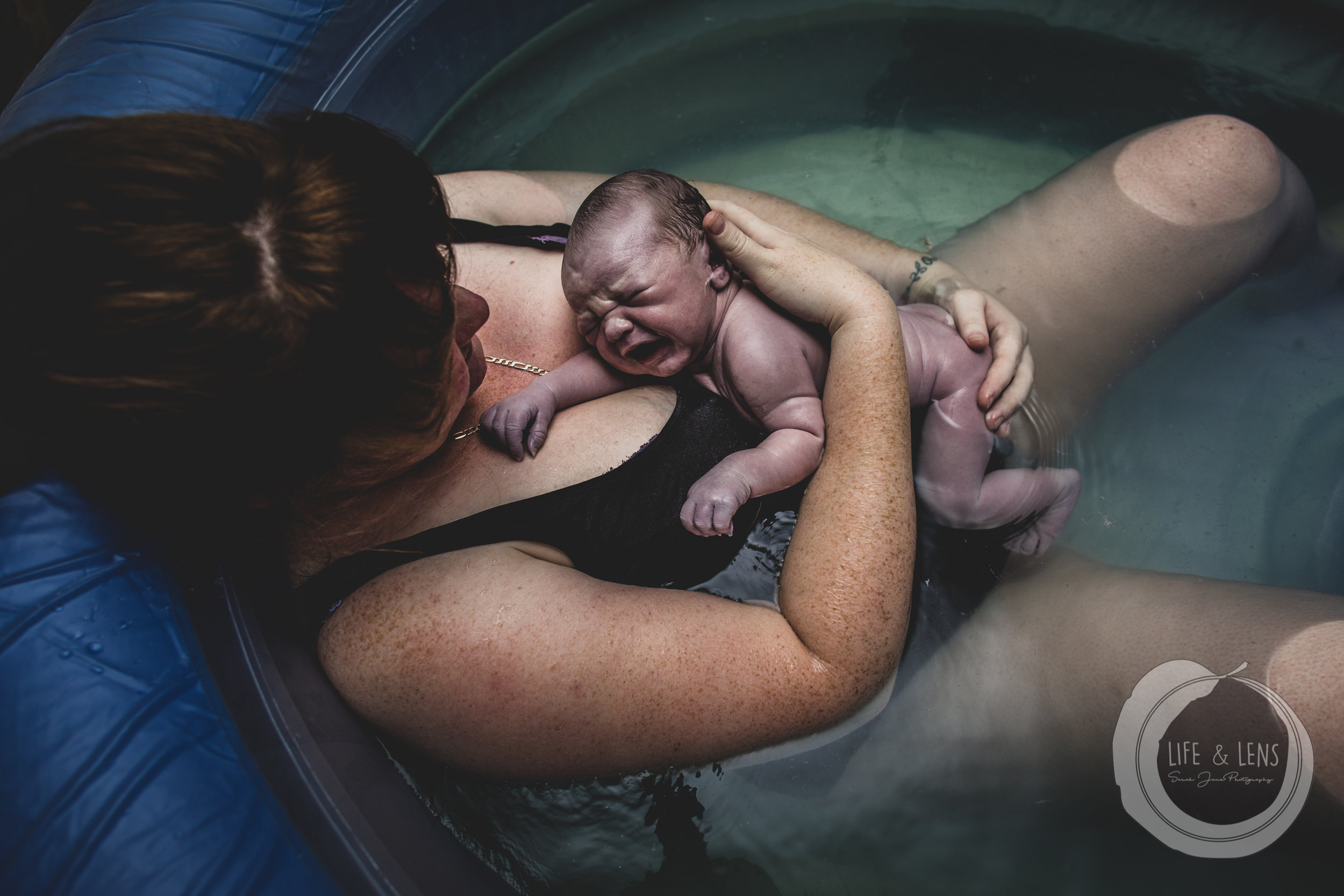Birth myths – A baby’s first breath…
Recently, I posted this beautiful image of a healthy baby boy who was born in water, at home. He is just a minute old in this image:

One of the things that hit home for me when posting this image, was the misconception that this baby was ill, all because of his skin colour immediately after birth.
– Yes. He is a tad purple.
– No. This is not a result of oversaturation in post processing.
– Yes. He took a moment or two to breathe after birth.
– YES. This is ALL completely normal.
MYTH: babies that are born blue/purple are struggling to breathe and require assistance/intervention.
FACT: Most babies take a moment or two to take their first breath, post birth, and require little to no stimulation/intervention to do so.
Until your baby takes their first breath earth side, they are supported fully by their umbilical cord and placenta. The placenta provides your baby with nutrients and oxygen and also removes waste products from your baby’s blood.
In normal physiological birth, even after your baby arrives earth side your baby will still be receiving oxygen through their cord and from the placenta. This process doesn’t cease at the moment of birth, it doesn’t cease when your baby takes their first breath – it ceases when the cord stops pulsing, goes limp and all blood has been drained from the placenta through to your baby.
Sometimes, babies do take a minute or so to take their first breath – and that is also completely normal.
Your baby has spent, on average, 9 months floating inside your womb, swallowing amniotic fluid and being sustained by the placenta. Their source of oxygen up until this very moment, has been through their bellies via the cord from the placenta.
Then they are born.
Thrust, but sadly more often pulled, from their mother’s and brought forth into this world filled with bright lights, loud sounds and many hands.
Slow it down. Give them a moment, literally, a moment to breathe, until such point they are still receiving oxygen from the placenta.
Let the mother, who has grown, nourished and nurtured this baby into existence, bring this baby up to her chest and stand back. See what transpires.

Another purplish baby immediately post birth
Completely undisturbed, the mother will look, talk and then touch her baby into breathing their first breath. The stimulation of the mother’s voice, touch and breath when she kisses her newborn will move her baby to take its first breath.
Traditional midwife of Cherokee nation, Sister Morningstar, calls this the “Newborn imprint”. The medical world has a version of this natural process and calls it “tactile stimulation to stimulate spontaneous breathing” – doesn’t quite have the same ring to it does it?
In the medicalised version, within seconds of the baby being born they are rubbed down with a towel, their feet are rubbed or flicked and sometimes their faces are touched/rubbed/tapped. Not too long ago babies were held upside down by their feet and their bums were slapped…. not even joking.

Baby showing purple skin tones immediately after birth.
But, is it necessary?
In 2017 an analysis of a study on tactile stimulation of preterm infants at birth was conducted.
The results from this analysis showed that there was large variability in the use of tactile stimulation of infants at birth and that in most occasions they could not observe a direct effect of stimulation.
In other words, there was no proven effect of the tactile stimulation of babies and these babies would have otherwise been moved to breathe on their own or by means of other stimulation (lights, sounds, mother’s touch etc.)
Another study proved similar results, this study of “Tactile stimulation during neonatal transition” was recently conducted this year (2018); during which video recordings and pulse recordings of babies during transition were analysed.
This study analysed just over 50 term and 50 preterm babies. 18 of the pre-term babies and 25 of the term babies were given stimulation at some stage post birth.
In the preterm group, babies were given respiratory assistance without stimulation, which rarely happened in the term babies. In the term babies group, most of the non-stimulated babies did not need any intervention.

Same baby, moments after birth. No longer showing purple skin tones.
The study was unable to measure any direct respiratory impacts of stimulation. However, in the term babies, the study showed that there was no change in the saturation or heart rate before and after the stimulation.
Of course, as with everything, there are legitimate situations which call for medical intervention and tactile stimulation of babies at birth however, it is a common misconception that it is required and should be our first point of call when a baby is born, and as referenced above, there are studies which prove this theory further.
Give the baby a chance to adjust to this new world and take their first breath organically. Allow the mother to stimulate the baby into breathing and then, if legitimately necessary, resort to medical intervention.
Let nature do its thing.
So yes, the baby in the image I posted was purple and he did take a moment to breathe however, within moments he was crying, cooing, breathing and breastfeeding and his colour soon turned to pink.



